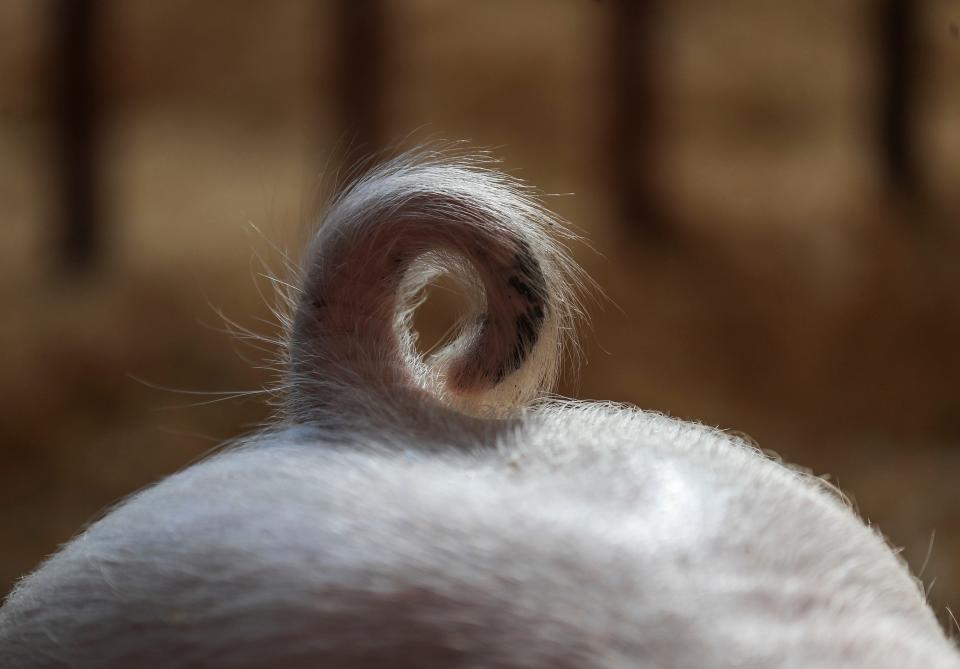Lost Recipes: Eat high on the hog with these pork parts
It’s time to go whole hog in Lost Recipes as we looking back on the many pig parts people cook — beyond beloved bacon, Boston butts, ham and pork chops. The saying is that everything in the pig but the squeal gets used, and that seems to be pretty accurate.
For instance, in 1893, the Montgomery Advertiser wrote about how to make waffles. These days, you’d probably spray the waffle iron with a little bit of cooking oil to keep your waffle from sticking while it cooks. Back then a pig part came to the rescue. They rubbed the iron with a pork rind and listened for the sizzle as the fat melted before they poured the batter in.
That actually sounds pretty good. I bet bacon grease would be even better.
We're taking readers into hog heaven, but there’s so many uses that we can’t contain it to a single column. This is part one of our journey into pig parts. Look for part two next week.
Pig ears

Another old saying is that you can’t make a silk purse out of a sow’s ear — but you can make it into a meal. Okay, I added that last part. They went well served with pea soup, the Advertiser wrote in 1930.
If you’re going to cook pig ears at home, start by cleaning them. Put them in a large bowl, with some vinegar and course salt, and scrub them. When they’re clean, rinse them off and put them in boiling water to cook for an hour. Then you just chop them how you want and season to taste.
Pig ears were a fairly common street food back in 1912, and in one instance led to an assault in Chicago. Seriously. Here’s the story the Advertiser ran in a nutshell: A guy bought a hotdog from a stand, liked it, and decided to get a pig’s ear there also. But as the buyer walked down the street eating it, he realized the pig’s ear he’d purchased “was not sound” — whatever that means. He threw the pig ear away, walked back to the stand, and demanded a refund. The argument got heated, and the stand owner slashed Bradford in the face with a knife. Both men were arrested. The moral of the story: Inspect your pig ears before you walk away.
Pig ears are still being eaten today. In 2020, Advertiser reporter Marty Roney represented the Montgomery Advertiser proudly in a pickled pig ear sandwich eating contest against Prattville Police Chief Mark Thompson. Roney said that pickled pig ears “taste like meat Jell-O.”
Roney lost the contest, which he said was “hard to swallow.” But he likely wouldn’t have eaten more pig ears if he could.
“Hey, I said I had eaten pig ear sandwiches before,” Roney wrote after his defeat. “I never said anything about liking them.”
Pig knuckles
In 1909, the Advertiser talked about how people bond over shared food loves, including pig knuckles — AKA pig’s feet.
“Should an acquaintance truly appreciate pigs’ knuckles, a sympathetic bond unites them,” we wrote. “They are brothers and can borrow money off each other.”
Seems like an odd thing to bond over. Then again, my earliest years were spent in my dad’s little country store gas station, and he had one of those big jugs of pickled pig knuckles on the counter. My dad knew just about everyone, so maybe the pig knuckles had something to do with it.
Apparently the trick to cooking pig knuckles into a tender state is to use as little water as possible when boiling them, according to the Advertiser in 1940. Then open a can of sauerkraut and arrange it over the meat in the pan, to let the flavors blend while it heats up.
Pig tail

In 1929, the Advertiser wrote that Montgomery’s population of 60,000 was the biggest pig tail consuming area in the country — about 75,000 pig tails a month.
“If every inhabitant of the nation loved pig tails like Montgomerians do, it would take exactly 1,800,000,000 hogs to furnish pig tails to supply the pig tail appetite,” we wrote.
One way to eat them is in otherwise fishy Kalaloo soup, with this recipe published in 1991:
3 or 4 pickled pig tails
4 medium porgies or blue fish
4 conch (optional)
1 medium onion, chopped
2 10-ounce packages of okra, chopped
16 ounce package of spinach, chopped
16 ounce package of collard greens
16 ounce package of mustard greens
1 large eggplant, peeled and diced
Water
Salt
Pepper
Hot Pepper
Pound the conch to tenderize, and place it in a large pot with the pig tails, with enough water to cover the meat. Cover it and boil for about 1 ½ hours until the conch is tender. In a separate pot, boil the fish until it is thoroughly cooked. Take the fish out, and set the water aside for use later. Flake the fish, removing skin and bones. Add the fish and all remaining ingredients to the conch and pig tail pot, and boil for 45 minutes. Season to taste.
IF YOU TRY IT
If you decide to try one of these lost recipes please send us a photo and a note on how it went. Send it in an email titled "Lost Recipes" to Montgomery Advertiser reporter Shannon Heupel at sheupel@gannett.com.
This article originally appeared on Montgomery Advertiser: Lost Recipes: Eat high on the hog with these pork parts

